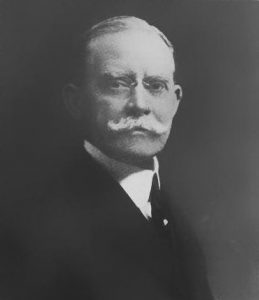
Did you know that November is National Entrepreneurship Month? Throughout November, we plan to highlight some legendary entrepreneurs who are also considered sales greats. We are kicking off our series with a profile of John H. Patterson.
John H. Patterson formed the National Cash Register Company in 1884. The company grew from producing only 16,000 cash registers in its first decade to producing 110,000 cash registers per year by 1914. (source: http://www.ohiohistorycentral.org/w/John_H._Patterson) Patterson’s aggressive sales & marketing push helped catapult the company to success. He is considered by many to be the father of modern sales training. (source: http://www.inc.com/ss/10-greatest-salespeople-of-all-time).

As well as being among the first entrepreneurs to organize sales training programs and retreats, Patterson is known for his use of sales scripts with his sales teams. The first N.C.R. sales script contained both instruction on what to say and what to do while saying it. In the Primer, as the script came to be called, an asterisk indicated to the salesman when he should motion to the item to which he was referring at that point in the script. (source: http://hbswk.hbs.edu/item/1143.html)
The Primer outlined a four-stage process for every sale: the approach, the proposition, the product demonstration, and the close. His script and technique essentially set up the sales person as a consultant:
- The Approach: The task of the salesman at this step in the sales process was to explain how he wanted to help the potential customer increase his profit.
- The Proposition: The “win” here was to gain an agreement to schedule a demonstration of the register.
- The Demonstration: Here the salesman demonstrated the features of the equipment and attempted to lead the potential customer to the point of purchase.
- The Close: The salesman would ask for the sale when the time seemed just right. If the prospect objected, the Primer laid out a series of ways to overcome objections.
(Check out this great article on the Harvard Business School website to learn more about what happened during each step in the approach: http://hbswk.hbs.edu/item/1143.html)
Recognize any of those strategies in today’s sales efforts? The main difference between today and John H. Patterson’s time is the use of telesales methods. One might even say that well-crafted scripting is more important than ever since a sales representative does not have the luxury of seeing facial expressions and body language of the prospect during the course of the sales pitch.
Here are the key takeaways from the example of John H. Patterson for sales people and entrepreneurs in the 21st century:
- Training – ensure your sales team receives adequate training. Use an inside sales software solution that has monitor and eavesdrop features for that critical onboarding period when a new sales rep is brought on board.
- Call Center Scripting Software – help your sales team by providing great scripting that helps them overcome objections. Telesales software with logical branch scripting can assist your sales reps with overcoming objections and closing more sales.
- Email Marketing Software – beyond the actual call, your reps have more ways than ever to communicate with customers. Be like Patterson, and ensure you have control of the message by implementing systems that use management-approved email templates and an audit trail of email history.
- Appointment Setting Software: if your first line reps set appointments for demonstrations for other agents, ensure you have appointment setting software made for team-based selling.
Get started building your empire by tightening up your sales process. Start your VanillaSoft Free Trial today!


